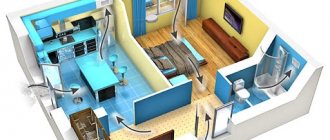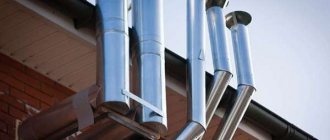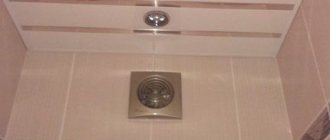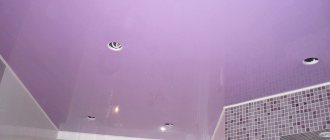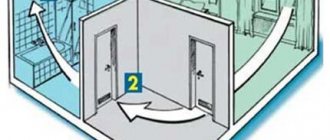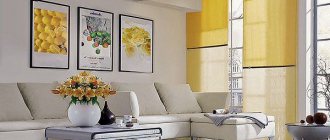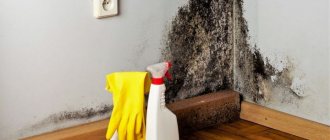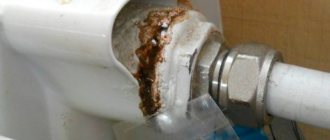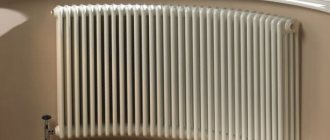Air exchange is important for any room, regardless of its purpose. Construction projects always include natural ventilation through ducts. But the quality of natural air exchange depends on a number of factors: weather conditions, cleanliness of air ducts, building height.
The variety of these parameters and their influence on the air exchange of the ventilation system is great. But a simple way to neutralize these factors is forced ventilation of the room, ensuring constant stable gas exchange.
About forced ventilation
The main distinguishing feature of forced ventilation is control of the volume of air exchange in the room. The amount of incoming air when using natural ventilation varies even depending on whether the windows and interior doors are closed or open at the selected time. When using a natural type system, the air flow may not be intense enough. Or, on the contrary, too quickly, additionally bringing heat, cold, and dampness inside the room. Artificial ventilation will allow you to regulate the gas exchange process, maintaining a comfortable indoor microclimate.
Forced ventilation is installed in an apartment, house or any standard room that requires gas exchange. The process involves the installation of technical means that can enhance and control the incoming flow of fresh air. The simplest and least expensive option is mechanical ventilation, which consists of a motor with an air propeller. Depending on the choice of location for its installation, ready-made systems are called:
- Supply air units are installed at the entrance of fresh air into the room.
- Exhaust - forcibly eject the used air mixture from the room.
- Supply and exhaust systems are a complex combined system that combines both options.
The fan is the main device for controlling the movement of air masses in each forced-air system. It is not always the most expensive component of the system, but is used in every scheme. Sufficiently effective ventilation with simple mechanical stimulation of air movement can be easily created with your own hands with a minimum of investment.
Of course, climate control systems on the market are often very expensive. But they offer not only the opportunity to “blow out” air from the street. The range of capabilities of modern ventilation systems is quite extensive - from simple air exhaust to fairly fine control of the microclimate inside the entire building.
The choice of a suitable model must be made based on where it is in demand: in a private home, office or apartment. Many systems are capable of not only forcibly supplying fresh air from the street, but also purifying it of impurities, warming, cooling, and dosing it. For example, installing highly productive functional ventilation in a garage is unprofitable. A simple household fan for the exhaust vent in the office will not be enough.
Air balance
When calculating forced ventilation, a positive balance should be maintained. This means that the volume of supply air is greater than the volume of exhaust air.
If it is customary in the house to tightly close doors with baseboards, you need to equip them with grilles for ventilation. Then the air can circulate freely from room to room.
Air is supplied and removed mechanically into enclosed spaces.
The ratio of supply and exhaust in premises for various purposes.
| Purpose of the room | Innings | Outflow |
| Living room | 200 cubic meters/h | 200 |
| Bedroom | 250 cubic meters/h | 200 |
| Corridor | – | 50 |
| Kitchen | 100 cubic meters/h | 150 |
| Combined bathroom | 50 cubic meters/h | autonomous |
| Total (required minimum) | 600 cubic meters/h | 600 |
Ventilation device
Artificial ventilation differs from natural ventilation in its ability to forcibly create and control the movement of air flows of the required intensity. This category includes both ordinary household fans for exhaust vents and expensive complex air conditioning systems.
When choosing the optimal system option, it should be taken into account that its effectiveness depends on operating conditions. Inexpensive types of household mechanical ventilation are usually designed for installation on standard ventilation ducts. More complex systems require separate ductwork, increasing not only efficiency but also overall cost.
The device for domestic forced ventilation is quite simple. It is a combination of various elements that activate or improve the quality of air exchange. The classic elements of the system are:
- Protective grilles for ventilation ducts. They protect the exhaust openings from the entry of debris, insects, and small rodents, but do not impede air movement.
- Air filters. A forced ventilation system equipped with an air filter allows you to protect the room from fine dust and flying debris. There is a huge variety of filters of varying degrees of purification.
- Air valves. They help regulate the air flow coming from the street through the air intake. Provide additional protection for ventilation elements during the cold season.
- Mechanical fan. The main pumping element of each forced-air system, on which the ventilation performance indicator depends.
- Sound absorbers. Allows you to reduce the noise level during system operation.
- Heater or recuperator. They help equalize the temperature between incoming and outgoing air flows. Using a recuperator reduces energy costs for heating the room.
- Air ducts and ventilation ducts. Air duct pipes are an essential element of any ventilation system. They supply fresh air from outside, regulate movement through the building and remove it from the premises.
- Automatic climate control devices. They differ in variety, cost and range of functions. For example, the compact and inexpensive tion o2 fresh air breather allows you to forget about ventilating your apartment or office, providing round-the-clock freshness with the windows closed.
We recommend that you read: Bathroom hood
A forced system is needed when natural ventilation cannot cope. The easiest way to organize a mechanical hood yourself. But the best option remains the use of automatic climate control devices. They allow you to control a whole range of parameters of incoming air under any weather conditions.
The optimal choice of equipment for creating a high-quality forced ventilation system depends on the type of room in which it will be used. The garage does not need an air ionizer or a system for maintaining optimal temperature around the clock. A typical apartment rarely needs a separate recuperator. But it helps to significantly reduce home heating costs. There is a recommended set of devices for each room.
Model selection
types of forced ventilation
The basis of the forced ventilation system is a fan. It is he who is chosen based on the calculations made. This device is available in three models on the market:
- centrifugal;
- axial;
- channel
The first ones, also known as snails, are used mainly in industrial facilities. The second ones are used as hoods in apartments and houses. Still others get their name because they are mounted directly into the duct.
That is, the second category can be considered household. And here there is also a classification: window and ceiling. The first ones are also installed in ventilation ducts.
There is a group of fans that stand separately. These are high temperature models. They are more expensive than others. Places of their use are baths, saunas, boiler rooms, fireplace rooms. A distinctive characteristic is that they can withstand temperatures up to +180C.
In the apartment
The easiest way to turn natural ventilation in an apartment into high-quality forced ventilation is to install wall-mounted breathers. For example, the tion clever model will allow you to feel comfortable in the room even during the allergy season. The second advantage of compact wall-mounted models is their affordable cost and ease of installation. For any apartment with a ready renovation, breathers are considered the best option. They can be ready for use in just an hour.
The second option to provide all rooms of a house or apartment with a high-quality ventilation system is to create a PVU - a supply ventilation unit. But this is a labor-intensive, costly process, which must be planned as one of the options for major repairs.
A network of air ducts is created on the ceiling through which air is forced to move. The heart of the system is a bulky metal box with a powerful fan inside. It is capable of moving hundreds of cubic meters of air per hour, providing fresh air to every corner of the apartment. The disadvantages of this option are:
- High price. Installation is often an order of magnitude more expensive than purchasing and installing a wall-mounted breather or similar ventilation system.
- Labor intensity. To lay air ducts in each room, you will need to create many holes in the walls, which is associated with the appearance of a large amount of construction waste.
- Lowering the ceiling height. The ducts will need to be hidden behind a suspended ceiling to maintain the design of the room. Due to its large size, the main unit can only be mounted on a balcony or external wall.
- The need to use additional elements - air valves, heaters and others.
High-quality forced ventilation of rooms is not the only problem that needs to be solved. It is necessary to take into account the temperature difference between incoming and outgoing air flows, optimize the cost of heating rooms in the cold season, and solve the problem of summer heat. This is not too difficult to do, but very expensive.
Therefore, such forced PES schemes are considered the most complex. It is much easier to study in detail the tion breather or similar wall-mounted ventilation systems for an apartment. Many of them are much cheaper, can provide comfortable conditions for allergy sufferers, take up little space, and use energy sparingly.
General requirements for the organization
The most important requirement is to provide the people in the room with the required amount of clean air. There are certain standards for this indicator. One person requires 20-30 m³/h of air saturated with oxygen. If people stay in the room for several hours, then this value should not be less than 60 m³.
organization of forced ventilation
Of course, different characteristics of the premises themselves are taken into account in order to correctly calculate the air exchange rate. Eg:
- room area;
- its purpose: wet or dry, in the first case the air circulation should be greater to remove wet vapors;
- the number of people living or working in the premises.
To put it simply, forced ventilation in an apartment or house should be organized based on the ratio of the area of the room and the number of people in it. The smaller the area and the more residents, the more intense the ventilation system should work. That is, the power and productivity of the equipment should be higher.
In the house
High-quality mechanical ventilation in the house is an important condition for the comfort of country real estate. The construction design of apartment buildings initially includes ventilation ducts hidden in the walls. And for country cottages they are often considered as a separate additional element of comfort. The presence of an attic space opens up many possibilities for ventilating a private home, allowing you to choose an option of any complexity within your means:
- Combined system. A combination of forced exhaust and natural air supply into the room. It is easy to install and maintain, but often leads to increased energy costs for cooling or heating the incoming air.
- Forced supply ventilation with cooling. It involves installing an air conditioner at the inlet, supplying immediately cooled air. Increases the comfort of living in the house during the summer heat.
- Forced supply system with heating. The ventilation ducts are upgraded with a heat exchanger or recuperator, which helps equalize the temperature of the incoming air with the outgoing air. Efficient, economical and comfortable, but quite an expensive option due to the high cost of the recuperator.
- Supply and exhaust unit with air recovery. It uses a special supply and exhaust ventilation unit that can heat or cool the incoming gas by mixing air coming from the room. Thanks to heat exchange, the fresh air temperature approaches the optimum, allowing you to save on heating or cooling to comfortable values.
- Air conditioning system. An effective but expensive option in which supply air is supplied and serviced by an air conditioner. Depending on the power and set of functions of the device, the incoming air masses can be cooled, heated, subjected to ionization, cleaned of dust, bacteria, and qualitatively improved in any other way necessary for the user.
We recommend that you read: Ventilation of a pigsty
The simplest and most inexpensive ventilation device in a private home is a supply valve. The device consists of a damper with an air filter and is easy to install yourself.
When choosing the optimal ventilation option, keep in mind that high-quality gas exchange not only helps create a comfortable atmosphere in the house. It prevents the appearance of mold, dust, bacteria inside the rooms, maintaining the health of residents and the normal operational characteristics of the property itself.
Scheme
To create comfortable conditions in the house, a forced ventilation scheme is selected, which can be of several types:
- Supply air with a cooling function, which is mounted complete with the air conditioner. Disadvantages: high price, need for constant maintenance.
- Forced with air heating, provides for a recuperator (find out how to heat the ventilation here).
- Combined , combining both ventilation schemes. Easy to install, low maintenance.
- A recirculation system is a design whose installation requires knowledge and complex devices that mix outgoing exhaust air flows with the street atmosphere and return them back to the house.
Supply ventilation with cooling function:
Forced ventilation with air heating:
Combined ventilation:
Air recirculation system:
Advice
Please note that a massive installation for general ventilation of the house should be located away from living rooms, because the device will create noise even with insulation.
When choosing a ventilation scheme, the basic rule must be observed - air flows must circulate from residential rooms (bedroom, living room) to non-residential ones (bathroom, kitchen). There is no need to skimp on the quality of the design, because properly installed ventilation helps prevent the appearance of fungus and bacteria in the room, prevents the accumulation of dust, and ensures a good microclimate in the house, preserving the health of its owners.
In bathroom
The best option for improving the capacity of exhaust vents in bathrooms is a household fan. It is not difficult to verify its necessity - just hold a strip of newspaper paper to the ventilation grille. If it sticks to it, it means that the intensity of gas exchange can be considered sufficient. When the strip of paper does not stick or deviates only slightly, you should consider purchasing a household fan.
Unlike other rooms, sanitary rooms are an area of increased risk of mold formation. High-quality ventilation of a bathroom, toilet or combined bathroom is the basis for the comfort and environmental safety of the room. A humid environment plus stagnant air are ideal conditions for the development of pathogenic bacteria. Therefore, it is very important to ensure good ventilation of such areas.
Sometimes even purchasing a household fan does not help achieve the required level of ventilation in sanitary premises. The reason for this may be tight doors. The air is not removed from the room due to the fact that there is nowhere for new air to come from. The fan removes the gas, creating an area of low pressure. And the resulting pressure difference is equalized by the air that enters the ventilation duct from other apartments. This situation can be corrected by opening holes in the doors or creating a leaky doorway that does not prevent air from the apartment from entering the bathroom.
Choosing the optimal household fan for the bathroom is easy to do, based on the following recommendations:
- The productivity of the device must be at least 90 m3/h.
- The fan must be moisture resistant.
- A system with a device on/off timer is better than a device that only works when the light bulb is on.
- A household fan with a check valve is noticeably more reliable than exhaust devices without it.
Using these tips, you can choose a quality appliance for use in kitchens, bathrooms, bathrooms, or other areas with high humidity.
Characteristic advantages of supply and exhaust ventilation
By choosing a supply and exhaust system, you will receive a number of advantages:
- High quality and stability of air exchange under any external conditions (pressure, temperature outside the window, etc.) and in any room;
- Possibility of adding new modules that increase functionality;
- The ability to adjust the volume of removal and supply of air masses, change the temperature regime (heating or cooling) of the air, and effectively clean it.
To reduce heating costs, you can choose a system with heat recovery from exhaust streams.
Important: provides a full range of services for equipping residential and commercial properties with guaranteed high-quality and essential efficient air conditioning and ventilation devices.
In the garage
The garage is often mistakenly considered a non-residential area that does not require a separate ventilation system. Even if the room is rarely used, it is necessary to create mechanical air exchange in it. The owner’s comfortable stay in the garage, which is considered a non-residential premises, is not the main reason why the room needs high-quality air exhaust.
Good forced air exchange in the garage allows you to solve a number of problems familiar to many owners of such real estate:
- Prevent the development of mold and mildew on the walls.
- Ensure high-quality removal of exhaust gases and harmful volatile mixtures.
- Remove excess moisture brought inside with the car.
- Keep the walls, inspection pit, tools, etc. as dry as possible.
- Protect your car from corrosion caused by condensation.
High-quality forced ventilation of the garage allows you to maintain the functionality of everything stored in it. And savings on ventilation can lead to increased costs for car repairs, buying new tools or replacing other damaged items that were stored here.
Ventilators and supply valves
The appearance of these devices for maintaining an optimal microclimate is reminiscent of a compact hollow pipe. Both supply valves and ventilators are capable of providing a continuous flow of outside air into the room with doors and windows closed, without drafts.
Taking into account the location, the equipment is divided into wall and window. The cost directly depends on the functionality. Let's give a couple of examples:
- The Blauberg Fresher 50 supply valve, priced at 15 thousand rubles, can not only solve air exchange issues. But also increase the concentration of oxygen in the room, normalize humidity, protect walls and ceilings from mold and mildew, and prevent condensation. The design includes a 2-level filter element that captures large debris and insects. So do viruses, dust and microorganisms.
- The PS 100 supply valve, costing 1 thousand rubles, will also prevent the formation of mold and condensation. Street air will be continuously supplied to the premises. The product has an internal and external filter grid to ensure that the air masses entering the rooms are clean.
For ease of selection, each product in the Khoros catalog has detailed and reliable descriptions. If you have any additional questions, please contact our manager.
Calculation of forced ventilation
High-quality forced air exchange cannot be ensured without preliminary mathematical calculations. Calculation of mechanical ventilation includes mandatory calculations that help determine:
- Optimal system performance.
- Number and minimum effective power of fans.
- Type, necessity and performance of auxiliary elements.
- Section of ventilation ducts.
- Noise level of a working structure.
The main indicator when carrying out calculations is the calculation by multiplicity. Multiplicity is a number indicating how many times per hour the air in the room will completely change. Based on it, the required performance of the working elements of mechanical air exchange is calculated. Each room in the apartment has its own minimum multiplicity standards, which can be easily clarified using SNiP tables.
Why do problems arise?
A natural ventilation system is installed in multi-storey buildings taking into account regulated air exchange standards and sanitary and hygienic requirements. However, often its power is not enough to create a favorable microclimate.
The reason for this is extremely simple: natural ventilation requires an air flow for normal operation. Otherwise, the draft decreases or a vacuum forms in the rooms. Air must enter buildings through cracks and gaps in window and door units.
However, modern plastic windows and metal doors with seals are so airtight that they not only prevent heat loss. But they also prevent air flows from “sneaking” into the rooms.
Another common reason for significant reduction in natural ventilation performance is insufficient maintenance of communications. This leads to their littering and a reduction in the diameter of the ventilation ducts.
Calculation by area
Calculating mechanical ventilation by area is the second way to calculate the overall performance of a future forced air exchange system. This option is often used to calculate a DIY installation. During calculations, it is recommended to adhere to the general recommendation, regardless of the size of the premises. It consists of the following - for any room with a ceiling height of no more than 3 meters, the final air flow is three cubic meters per square meter of area per hour.
We recommend that you read: Ventilation ducts made of plastic pipes
Calculation of the cross-section of air ducts
Calculating the area of ventilation ducts is an important point in the design of each ventilation system, regardless of complexity and performance. The cross-sectional area of the air ducts is a parameter that directly affects the maximum speed of movement and volumes of exhaust air.
For natural ventilation, the normal speed of air flow is one and a half meters per second, for forced ventilation - 3.5 m/sec. It is not difficult to calculate the optimal cross-section of the air duct, knowing the operating capacity of the assembled structure. The second option for carrying out calculations is to use diagrams for selecting air duct sections containing standard recommended values.
Calculation of local hood parameters
To absorb emissions and vapors hazardous to human health, suction units made in the form of umbrellas are installed. If they are difficult to purchase, you can always make them by preparing the appropriate drawing.
At the first stage, the following data and parameters are determined:
- area of release of harmful substances – a * b, as well as the diameter of the umbrella – d;
- air movement speed at the work site - VB;
- calculation of local exhaust ventilation is carried out taking into account the suction speed into the umbrella - Vз
- the height of the installation of the structure above the source of hazardous pollutants is designated Z.
One of the key parameters that determines the efficiency of absorption of harmful substances is the installation height of the exhaust hood. Engineers recommend hanging it as low as possible to the work area so that all fumes and emissions are effectively absorbed and removed.
The installation of exhaust ventilation is carried out based on the following dimensions of the umbrella:
D = 0.8×Z+d, taking into account other parameters – A = 0.8×Z+a, while B = 0.8×Z+b.
The optimal level of umbrella opening is 60 degrees. With this value, the danger of the formation of stagnant zones is eliminated. If we are talking about a very low room, it is better to increase the opening angle to 90 degrees. As for the height of the lower edge, it ranges from 180 cm. The hood is connected to the ventilation in such a way that there is access to the folding curtains from 3 sides.
For rooms where the speed of movement of air masses is from 0.4 m/s, it is better to supplement the umbrella with special folding curtains. The presented calculation data will help you more accurately determine the cost of the finished product, as well as determine the appropriate equipment. However, before connecting the hood to the ventilation, it is better to consult with a specialist who can carry out the appropriate calculations and recommend specific models of devices.
Selection of equipment for forced ventilation
There are two types of forced ventilation system - expensive or made with your own hands from available components. High-quality options always include expensive equipment, for example, installation of an anti-freeze recuperator or air conditioner. Economy class air exchange schemes offer a partial solution to the problem of slow air exchange, but their performance depends on weather conditions.
In addition, regardless of the thickness of the walls, the exhaust fan always produces some noise during operation. High-quality systems or indoor wall-mounted breathers are characterized by minimal noise levels. Therefore, their installation can be carried out in almost any convenient place. The installation site for a powerful working unit of economy class options or home-made high-performance systems should be located as far as possible from bedrooms and lounges.
Properly selected equipment should not be audible behind two tightly closed doors. The easiest way to achieve this is for private property owners. After all, cottages allow you to create a network of heat exchanger channels in the attic and place the main operating unit there. In apartment buildings, the usual installation location is the outer wall of the building.
Features of ventilation systems for kitchens
When choosing fans, it's important to consider more than just size and performance. Ventilation in the kitchen should be equipped with a special mesh to prevent insects from visiting the house from the ventilation shaft
An important requirement from customers is the removal of the front panel to ensure convenient cleaning. To prevent odors from someone else’s kitchen from entering the apartment through the ventilation ducts, it is necessary to select a device that has a check valve aimed at preventing the opposite draft.
Homemade ventilation in the kitchen can be supplemented with a switch on the cord.
About natural ventilation
The natural ventilation system became popular during the construction of old-style private houses. Minutes of the system according to this scheme require constant checking of the drafts of the ventilation ducts. For proper verification, two options are used.
- If a natural device is installed under the ceiling, then applying a sheet of paper is enough: when you cover the ventilation with it, the sheet will stick and display the working status of the ventilation in a private house.
- In addition to the sheet, the system is checked with a lit match or lighter. When the ventilation system is working, the flame will change direction.
You can check the ventilation duct drafts using a lighter.
If there is no result, only specialists can help solve the problem. By the way, using natural ventilation schemes, you can “reward” yourself with a lot of problems due to the shortcomings of the device and ineffective operation.
The disadvantage of a natural ventilation system with no auxiliary fans is that it can lead to draft overturning due to external factors or changes in air direction. That is why it is better to ensure that the channels are located outside - for example, on the roof.
An important stage in this process is the insulation of pipes and air ducts passing by cold places. With ventilation ducts leading outside, their operation will only occur when the fan is turned on.
About the compulsory system
Forced ventilation does not resemble natural ventilation, because it is truly the most effective system that participates in sufficient air exchange in a private home, kitchen premises, etc. With the correct selection of parameters, when the air exchange rate is taken into account, the operation of forced kitchen ventilation will be effective and long-term.
A forced ventilation system is installed when the natural type of organization is problematic and other ventilation devices are ineffective. The kitchen room is equipped with a forced device in certain cases. When supply valves are installed separately, which provide air exchange, and exhaust fans are installed at the entrance to the mine shaft. Both devices operate on the principle of mechanical air injection.
If we are implementing a forced system, it is important to remember the variety of options available, some of them are fully automatic, and some have special sensors aimed at detecting humidity and temperature levels. Such additional arrangement is necessary for more economical calculation of electricity
When choosing equipment for your home, consider some factors.
- When installing a forced ventilation duct system, stacked ventilation will be the best choice. She will arrange not only a private house, but also other large-sized areas. Despite the fact that there are smaller options, none of them are suitable for low ceilings.
- You can opt for monoblock forced ventilation. Such a ventilation device is fully automated, has an air supply and exhaust fan, filters for fine and coarse cleaning and dirt removal, a heater and a cooling section.
The above can be combined by summing up the work of the compulsory system. An installed forced ventilation device is necessary for houses with a non-working natural system. There is also a need for a forced-type ventilation device for those whose air does not flow from the street into the house, is not purified, and does not go outside.
DIY forced ventilation
The simplicity of the design of the device makes it easier to carry out independent installation of forced exhaust ventilation. Supply and combined options not only cost more, but require certain construction skills and the use of special tools. The installation process of an inexpensive supply system includes the following steps:
- A hole is created in the wall of the building for the supply valve.
- In order to fill the room with warm air in winter, the optimal choice for placing the supply valve is the area above the central heating radiator.
- A hollow pipe with a special valve mechanism inside is inserted into the hole and securely fixed.
- The external inlet is protected by a grill that prevents small objects or debris from entering the pipe.
- The gaps are filled with construction foam, and after drying, the excess foam is cut off with a construction knife.
- A soundproof box is installed on the part of the pipe located indoors.
Now let's look at how to make forced ventilation of the exhaust type. It is created much simpler - a household centrifugal fan of the required power is installed on the outlet ventilation hole. The choice of the best model is strictly private, but it is best to pay attention to devices with a minimum noise level.
Types of ventilation systems
There are several types of room ventilation:
- Natural – so-called ventilation with natural impulse. It operates due to the difference in temperature and pressure inside and outside the room.
- Forced - the inflow and outflow of air masses occurs due to mechanical devices (fans).
- Combined - only the inflow or outflow of air masses occurs due to mechanical devices (fans).
Scheme of operation of forced ventilators
The operating principle of the natural type of ventilation is the influx of clean air flow and the outflow of already polluted and carbon dioxide-saturated air without the use of mechanical means. New air enters through windows, vents and open balcony doors. The exhaust is exhausted through ventilation vents located in the bathrooms, kitchen and storage rooms.
In small living spaces, natural ventilation is sufficient. For a multi-room apartment or a country 2- or 3-story house, you will need to install a forced supply and exhaust ventilation system.
To understand whether natural ventilation needs to be modified, you need to pay attention to certain indicators of poor air exchange and figure out what needs to be strengthened - air inflow or outflow. It is often necessary to force both the air intake and its exhaust
There are several signs indicating that the ventilation in the apartment is not functioning well enough:
- high humidity in summer
- low humidity in winter
- mold appears on the walls in the kitchen and bathroom
- feels constantly stuffy
- the air smells like food or sewage
If at least several of the above factors are detected, then the installation of a forced ventilation system is mandatory for this room. It will help get rid of various diseases of the respiratory system of all residents of a house or apartment, the presence of increased levels of carbon dioxide, the accumulation of unpleasant odors, and the development of pathogenic microorganisms.
Advantages of a forced (mechanical) supply and exhaust ventilation system:
- High-quality air filtration.
- Humidification and ionization of particles.
- The process of both heating and cooling air.
Additional components and their purpose
An apartment's forced ventilation system may include some additional components in addition to the necessary fans and air ducts. Their inclusion in the overall scheme makes it possible to improve air quality and provide the most comfortable living conditions. Their list is as follows:
- Ventilation grilles that protect the ducts from the penetration of rodents or the accumulation of dust. As a rule, they are installed on the outside of air ducts and also perform a decorative function.
- Valves or louvers provide regulation of the speed and volume of supply air, and, if necessary, can completely block them.
- Air heaters organize heating of supply air in winter.
- Sound absorbers eliminate all extraneous noise that comes from the street or appears due to the operation of fans and other mechanisms.
- Aerofilters prevent any small debris, dust and plant pollen from entering the apartment.
- A control unit that controls the functioning of the entire system, turning on or off certain parts of it. It operates fully automatically based on specified parameters and requires a constant supply of electric current.
The installation of all these devices does not at all affect the functionality of the ventilation system in the apartment, providing additional comfort for its residents. Their installation is carried out solely as a modernization and only helps to improve air quality, but does not in any way affect its mobility.
Selecting a recuperator by design type
It cannot be said that any recuperator is worse or better; each type of recuperator has its own strengths and areas of application. The efficiency of a rotary and plate recuperator is absolutely the same, since the efficiency depends on two parameters: the area of the heat exchange surface of the recuperator and the direction of the air flow in the recuperator.
The design of the rotary heat exchanger allows partial mixing of the supply and exhaust flows, since the air flow insulator in it is a brush. A brush with fine bristles, in itself, is a poor insulator between air flows, and a slight imbalance in the system leads to an even greater flow of exhaust air into the supply channel. Also, the weak link in a rotary recuperator is the engine and the belt that spins the rotor: additional moving parts reduce the overall reliability of the equipment and also increase energy costs for recuperation. The rotary heat exchanger can only be installed in one position, which also reduces the possibility of its use at home. The main objects for the use of rotary heat exchangers are shopping centers, hypermarkets and other public buildings with a large area, where air flow is only for the benefit of the building owners.
We present a diagram of the operation of a rotary recuperator.
Plate recuperators, unlike rotary devices, are not so massive, but at the same time they are easy to install and reliable in operation. Among plate recuperators, membrane-type equipment deserves special attention. A special polymer membrane built into the recuperator returns moisture from the exhaust air to the supply air. At the same time, it prevents the formation of condensation, as well as the formation of ice inside the device (during its operation at low temperatures).
Based on plate recuperators, it is possible to build multi-stage recuperation, which allows you to avoid direct contact of the coldest air flow (coming from the street) with the warmest (coming from the house). And in conjunction with an enthalpy recuperator, this technology allows you to avoid freezing of the recuperator. A smooth decrease in the temperature of the exhaust air and a gradual increase in the temperature of the supply air inside the recuperator make the device resistant even to temperatures in the far north. As practice shows, such equipment works successfully in the most severe climatic conditions, for example, Yakutsk.
PiterPro user FORUMHOUSE
Plate heat exchangers use different materials. Plastic and metal heat exchangers freeze. Membrane heat exchangers use a thin film that only allows moisture to pass through. There are two or three heat exchangers in such an installation, depending on the model.
Efficiency is one of the main characteristics of a recuperator, and special attention should be paid to its value before purchasing an installation.
